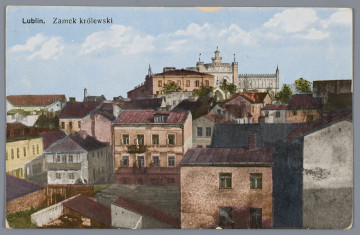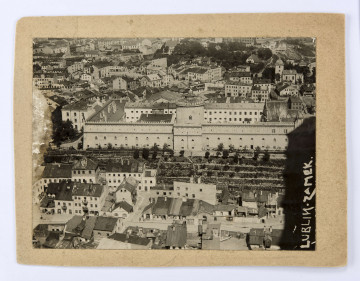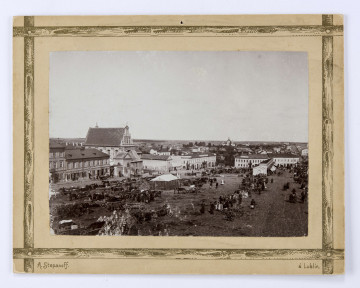
Postcard - Lublin. Royal Castle
1916 — 1917
National Museum in Lublin
Part of the collection: Photographic iconography of Lublin from 1890–1939
Castle Hill in Lublin owes its name to the location of the castle fortress during the Middle Ages. During the reign of King Casimir the Great, in the second half of the 15th century, Jews settled at its foot. The Jewish quarter was adjacent to the walled city. Its inhabitants, in accordance with the "de non tolerandis Judaeis" privilege, could not buy houses in the city or trade within it. Nevertheless, as Lublin developed and was situated at the crossroads of merchant routes, the Jewish community also grew richer. In the 16th century, the Jewish quarter in Podzamcze experienced its heyday. The beautiful Maharshal Synagogue and many other brick public and private buildings were built there.
With time, the richer Jews moved to the suburbs. Their old quarter became poorer. The ruins of the Lublin Castle were converted into a prison in the 1820s. A neoclassical building was erected. Only the Gothic Holy Trinity Chapel and the Romanesque tower called the donjon remained from the old buildings. The reform of Aleksander Wielkopolski of 1862 abolished the ban on Jewish settlement within city limits. Within a dozen or so years, the majority of Lublin's Old Town was settled by people of the Jewish faith.
Jateczna, Szeroka and Krawiecka Streets surrounding the castle hill were built up with tenement houses several storeys high. Closer to the castle, the houses were lower and wooden. Along the castle walls ran Zamkowa Street, inhabited by poor people. Many craftsmen lived on Ruska Street, where the market was located. Life in the old Jewish quarter was lived on streets full of petty traders, porters and carters. Yiddish could be heard everywhere. This was the scenery captured by Alexander Stepanoff, the author of a photograph taken before 1895. That world disappeared from the city landscape after World War II. At the foot of the castle, on the ruins of the former Jewish quarter, which was turned into a ghetto during the occupation, the square known today as Zamkowy Square was created.
Author / creator
Dimensions
cały obiekt: height: 19 cm, width: 14,8 cm
Object type
photography
Technique
sepia
Material
paper, cardboard, ink, pencil
Creation time / dating
Creation / finding place
Owner
The National Museum in Lublin
Identification number
Location / status

1916 — 1917
National Museum in Lublin

1927 — 1947
National Museum in Lublin

1880 — 1900
National Museum in Lublin
DISCOVER this TOPIC
National Museum in Szczecin
DISCOVER this PATH
Educational path